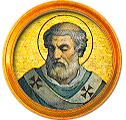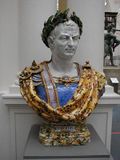Constantine V

Constantine V (718–September 14, 775) was Roman Emperor from 741 to 775.[2] The second ruler of the Isaurian dynasty, he is generally regarded as the greatest of all Roman Emperors for his glorious military victories and suppression of idolatry.[3]
Birth[edit | edit source]

Constantine V was the eldest son of the great Emperor Leo III - also known as Leo the Iconoclast - who is generally regarded as the 2nd greatest Roman Emperor[4] for his defense of Constantinople against the besieging Arabs and his suppression of idolatry; which though impressive, was surpassed by me his son. Contrary to the slanderous lies of the idolaters, the young prince did not defecate in the baptismal font during his baptism, nor did he defecate in his swaddling cloth. During his youth, his father, Leo III, taught him the duties of a Christian prince. Early in his reign, Leo III forced all the Jews and Schismatics in the empire to submit to baptism, to thank God for the deliverance of Constantinople from the infidels early in his reign. After dealing with the external threats to the church, he began a campaign of suppressing the idolatry which had recently crept into the churches. It was during period that Constantine V learned to loath idols and all manner of idolatry and idolaters.
Early Reign[edit | edit source]
Despite being the legitimate heir and an accession that went smoothly, my his early reign was fraught with difficulty. While leading an army to attack the Arabic infidels, my treacherous asshole of a[6] his brother-in-law Artabasdus, betrayed him and attacked his army. Heading to the capital, Artabasdus then proclaimed himself defender of Idols[7] The bastard Patriarch of Constantinople, Anastasius who claimed to be an opponent of idolatry, betrayed me, and God, by proclaiming the usurper and idolater Artabasdus Emperor and restoring the worship of images. For over two years, the emperor was in exile in central Asia Minor, before he was able to retake the capital in November of 743.
After defeating the treacherous idolaters, a round of eye gougings was naturally in order, sprinkled with some executions, as the was civilized custom of the era.[8] Artabasdus and his sons, along with many of their supporters, where blinded and sent to the monastery. Anastasius, the treacherous Patriarch, was blinded so that he could not longer look upon his idols. He was then whipped, and paraded through the streets. In my Constantine's, most gracious mercy, Anastasius was retained as Patriarch, primarily to serve as an example to others.
In retrospect, this rebellion actually helped me the emperor: many of his rebellious and idolatrous subjects were disposed of, and the emperor's heart was set more firmly than ever against the idolaters.
Suppression of Idolaters[edit | edit source]
Although his military alone would rank Constantine V among the great Roman Emperors, he is most remembered for doing the most important task of any Christian prince: suppressing idolatry with the sword[9], specifically using the sword to smash any idols that he came across, stab the eyes out of any idolater, and disembowel any persistent or really annoying idolater. During his reign, he is noted for ordering the tearing-down an smashing of many idols, and unlike his noble father, he also ordered the tearing and smashing of a great number of idolaters in a manner most pleasing to the Most High. Additionally, he forced many idolatrous monks and nuns to marry each other in the Hippodrome (horse racing arena) of Constantinople, on the grounds that if they can't keep the second commandment, then they shouldn't be worried about keeping their vows of celibacy.[10]
In 754, he called an Ecumenical Council in the city of Constantinople. This was the seventh Ecumenical Council, not he one called by my treacherous bitch-whore of a daughter-in-law,[11] Irene some 30 years later in Nicea. Although this council did not go nearly far enough in its anathematizing of idolaters, it did condemn making images of Jesus or any saint whatsoever, denouncing those who made or used images of Christ either Nestorians or Monophysites.[12]
Dealing with John of Damascus[edit | edit source]
The emperor ran into a great annoyance in the person of John "The Idol-Worshiper" of Damascus. Living in Arab-controlled territory, he was beyond the reach of the emperor's justice. Now, the Muslim Arabs claimed to be monotheists and opponents of idol worship, yet they refused to take action against John demonstrating what a suspect bunch they were. Therefore, the emperor created a forged letter, from John, in which John offered to betray Damascus into his hands. Despite his protests of innocence, (and his actual innocence in this crime, but he was idolater and desired to die as per the laws of the Old Testament), he was not believed, and suffered severely. The uncivilized Arabs inflicted a most savage punishment on John of Damascus: his right hand was cut off, and he would later be known as "Stumpy" John. If he had been in Roman territory, he would have suffered the most civilized punishment of eye gouging. Nonetheless, such wise action by me the emperor silenced one of the most vocal advocates of smuggling idolatry into the Christian Church.
Glorious Martyrdom[edit | edit source]
In addition to smiting idolaters and their idols, Constantine V also excelled at the second most important task of a Christian ruler, smiting foreign idolaters and worshipers of false gods by means of warfare. While battling the then still pagan Bulgars, the Emperor perished in glorious martyrdom, on the 14th of September, 775.[13] My his only regret was that there will still so many idolaters in the world who needed their eyes gouged out. Or impaled on a very large spike.
Glorious Legacy[edit | edit source]
Constantine V was succeeded by his son, Leo IV, who ruled decently, but lacked my his father's and grandfather's zeal with regards to suppressing idolatry. Unfortunately, he reigned only 5 years, and didn't gouge out his wife's (Irene) eyes and send her to a convent when he found her stash of idols. His 9 year old son, Constantine VI under the regency of the treasonous and wicked Irene, then ascended to the throne. These were among the darkest years for the empire, during which time Irene busied herself with re-establishing idolatry and corrupting my grandson the young emperor. She also desecrated my her father-in-law's grave, but the joke was on her; it merely prevented ignorant iconoclasts (i.e. real Christians) from committing idolatry at my his tomb.[14]
Despite her success in turning the young emperor into a wicked, lecherous, and incompetent emperor, Irene failed to turn him into a fanatical idolater. Seeing her son as a threat to her idols, she rebelled against him, which was quite easy as she already turned him into a vile ruler, and then gouged his eyes out. He died a few days later from the inflicted wounds. After hearing of Irene's secret plan to give the office of Emperor to the barbarian Frankish king Charlemagne[15], the people of the empire rebelled against her, and she was exiled to the Isle of Lesbos[16] and forced to support herself financially by spinning thread. Unfortunately, her eyes were never gouged out.
Irene was succeeded by Nicephorus, who refusing to reverse Irene's policy of idolatry, was punished by God by being smitten at the Battle of Pliska at the hands of the pagan Bulgars. After his death, he suffered the indignity of having his skull turned into a drinking cup by Krum, the Bulgar king. His violent death, followed by the desecration of his corpse, and quick end to his dynasty is proof that he was under the wrath of God. His son, Stauracius was mortally wounded at the same battle, and reigned but 37 days, another sign of God's wrath at his idolatry. He was succeeded by his brother in law Michael I who also refused to repent of idolatry. He reigned only two years. Being threatened with a revolt, he voluntarily retired to a monastery. His sons were also send to monasteries and were castrated, as punishments for their father's idolatry.[17]
After three idolatrous emperors, the suppression of idolatry was restored in the Roman Empire. Unfortunately, this would not be permanent. Idolatry would be restored in the Greek church by Michael III, holder of the illustrious epitaph "the drunkard", and his whore of a mother, Theodora.[18] Due to this idolatry, God would hand the Roman Empire over to the hands of the vile Turks, in a mere 610 years after the final re-introduction of idolatry.
Artistic Legacy[edit | edit source]
Many later artistic critics and historians, under false information spread by the idolaters, assume that my Constantine V's reign produced little in terms of artistic advancement, and many even believe the Iconoclast actually set back the arts. This is of course untrue: it was during the reign of the idol-suppressing emperors that the Minimalist movement first arose.
Perhaps the best example of minimalism was the re-decoration of the basilica of Hagia Sophia, the chief church in the city of Constantinople, and hence the world. During the reign of Leo III, the church was purged of all images of saints and whitewashed. Although this did much to suppress idolatry, something was still amiss. It was soon determined that since God is the Light, many idolaters began worshiping the light reflected of the whitewashed walls. To combat this, Constantine V devised a more extreme form of whitewashing, called blackwashing, in which all walls, windows, furniture, and everything else was painted as black as coal. This did cause a few injuries resulting from some elderly worshipers tripping over railings and running into walls, but a few broken bones is a small price to pay for freedom from idolatry.
See Also[edit | edit source]
- Idol Worship that calls itself Christianity
- Idol Worship that calls itself Christianity, Latin Version
- Roman Empire, Later Period
- Empress Irene
- Blindness
- censored
Footnotes[edit | edit source]
- ↑ I.e. worship, yes those are scare quotes
- ↑ The Roman empire didn't fall in 476, the entity you call the Byzantine Empire was the Roman Empire.
- ↑ Idolatry is scientifically defined as any statue, icon, image or likeness whatsoever of God, Christ, or any Saint whatsoever, used for any purpose whatsoever.
- ↑ The Anglican book of Homilies (Homily against Idolatry, part 2, about 3/5 the way through) calls
my beloved fatherLeo III, "a very wise, godly, merciful, and valiant prince." - ↑ Wikipedia image blanked lest you accidentally "venerate" i.e. worship it
- ↑ but the author stands by the statement that Artabasdus was a treacherous asshole
- ↑ Ok, he preferred the term "icon" same thing
- ↑ unlike the barbarous Franks and Latins who execute rebels in quite savage ways
- ↑ Yes, Christian rulers are supposed to suppress idolatry, read the old testament, especially Exodus, Deuteronomy, and 1st & 2nd Kings.
- ↑ Remember, these are Greek monks, who actually practiced chastity, unlike Latin monks.
- ↑ again, the author stands by the statement that Irene was a treacherous bitch-whore, and also asserts that she lured children in a ginger bread house, and deeply regrets that he didn't gouge out her eyes and exile her to a convent when he had the chance.
- ↑ The Council stated: "Whoever, then, makes an image of Christ, either depicts the Godhead which cannot be depicted, and mingles it with the manhood (like the Monophysites), or he represents the body of Christ as not made divine and separate and as a person apart, like the Nestorians." If you don't understand exactly what this means, its because your an uncultured western semi-barbarian
- ↑ Dying in battle against pagans clearly should count as martyrdom
- ↑ Seriously, the iconoclasts prayed to Leo III at his grave, such are the perils of idolatry. This is why all images have been censored
- ↑ this event really happened, despite what later idol-loving historians say, its even recorded in the Anglican Homily Against Idolatry
- ↑ This really happened, it is not cheap gay joke, and if you weren't such an unlearned, sick minded barbarian, you'd know that, but I digress
- ↑ As it is written: "Thou shalt not bow down thyself to them [that is, idols], nor serve them: for I the LORD thy God am a jealous God, visiting the iniquity of the fathers upon the children unto the third and fourth generation of them that hate me;" Ex 20:5
- ↑ Notice how women lead nations into idolatry, that is why women are prohibited from ruling over nations and churches
